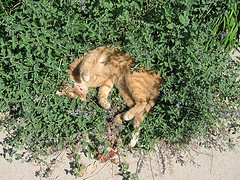Skip to main content
15 Facts About Catnip
Chances are, you've seen a cat respond to catnip by rubbing all over it, kicking at it, going crazy, writhing around on the floor…basically going nuts just by sniffing it! We wanted to find out just what it is about catnip that makes our kitties go crazy, and we learned some interesting things:
- Catnip blooms with small white or purple flowers, but the nepatalactone that affects kitties is found in the leaves and stem.
- Catnip is an herb and a member of the mint family. It’s scientific name is Nepeta cataria.
- Catnip is also known as catswort or catmint.
- It’s native to Europe and was imported to the US and other countries (and now grows like a weed all over North America!)
- A chemical in catnip, nepetalactone, is what’s responsible for giving your cat the familiar “buzz”.
- The catnip buzz only lasts for about 10 minutes. Then your kitty gets used it you’ll have to wait about two hours before your cat is susceptible to it’s powers again!
- Though often compared to LSD or marijuana, catnip is not generally harmful to cats – they cannot overdose on it.
- Male cats tend to like catnip more because the same chemical can be found in a female cat’s urine. Ew!
- Some cats like to eat catnip, but the most intense experience is had when your cat smells it. When eaten, catnip seems to make cats mellow, but when they smell it, they typically react with excitement.
- Sensitivity to catnip is genetic. About half of cats won’t respond to it at all.
- Approximately 30% of domestic house cats who do not react to catnip will react in a similar way to Tatarian honeysuckle sawdust.
- Young kittens and senior cats typically don’t react to catnip. In fact, the trait doesn't develop until between 3 and 6 months of age.
- If made into a tea, catnip can be used by humans as a calming aid, similar to chamomile.
- Nepetalactone is an excellent mosquito repellent. It’s said to be ten times more powerful than DEET, a common chemical repellent. Unfortunately, it only lasts for a few hours before it become ineffective. It’s also effective against cockroaches and termites.
- Store your catnip in an airtight container or in the freezer to keep it fresh. It will lose it’s potency over time.
SOURCE: Brooke Arnold, Content Editor for Catington Post; certified cat lady!





Comments
Post a Comment